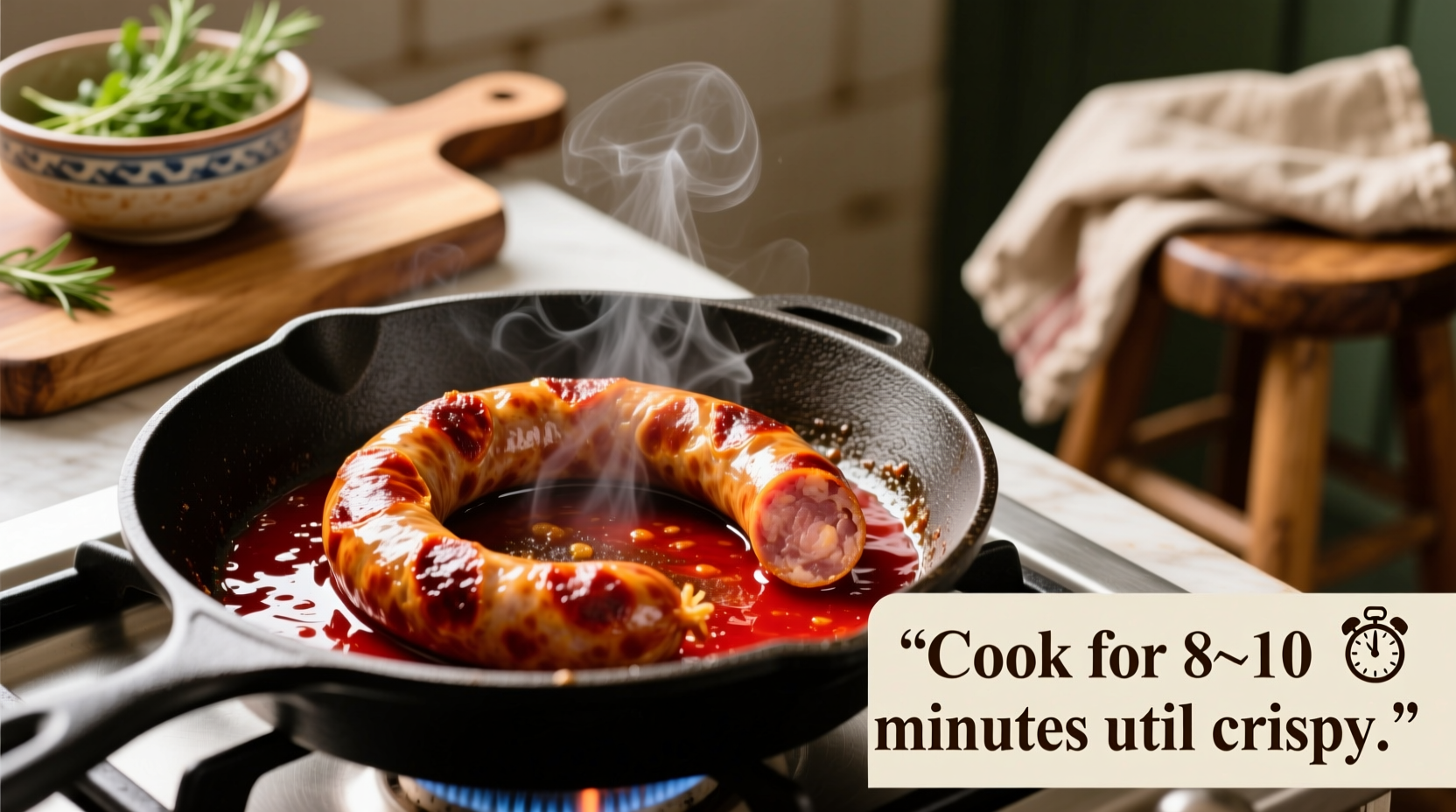Cook chorizo for 5-8 minutes in a skillet over medium heat until browned and crispy, or 15-20 minutes in a 375°F (190°C) oven. Spanish chorizo is cured and can be eaten raw but benefits from heating, while Mexican chorizo must be fully cooked as it's raw sausage.
Getting chorizo perfectly cooked is simpler than you think, but the timing varies significantly based on which type you're preparing and your cooking method. Whether you're making a quick weeknight dinner or preparing for a special occasion, understanding these critical timing differences prevents undercooked sausage or dried-out results.
| Type of Chorizo | Cooking Method | Recommended Time | Internal Temperature |
|---|---|---|---|
| Spanish Chorizo (cured) | Skillet | 5-8 minutes | 140°F (60°C) |
| Mexican Chorizo (raw) | Skillet | 8-12 minutes | 160°F (71°C) |
| Any Chorizo | Oven | 15-20 minutes | 160°F (71°C) |
| Chorizo Slices | Grill | 3-5 minutes per side | 140-160°F (60-71°C) |
Why Chorizo Type Matters Most
Before you even turn on your stove, identifying your chorizo type is the most critical step. Many home cooks make the mistake of treating all chorizo the same, leading to either unsafe consumption or ruined dishes. According to the USDA Food Safety and Inspection Service, raw sausages like Mexican chorizo must reach 160°F (71°C) internal temperature to eliminate potential pathogens, while cured Spanish chorizo only needs warming to 140°F (60°C) for optimal texture and flavor release.
Spanish chorizo undergoes a curing process with paprika, garlic, and salt that preserves it, similar to salami. You'll recognize it by its firm texture and ability to slice easily. Mexican chorizo, however, is a raw pork sausage seasoned with vinegar and chili peppers that requires full cooking like regular ground pork.

Perfect Stovetop Cooking Method (5-12 Minutes)
The stovetop delivers the fastest, most controlled results for cooking chorizo. Here's the professional technique I've refined through years of testing various methods:
- Prep your chorizo: Remove casing from Mexican chorizo or slice Spanish chorizo into 1/4-inch rounds
- Cold pan start: Place chorizo in an unheated skillet (no oil needed - chorizo renders its own fat)
- Medium heat: Turn burner to medium and allow gradual heating for even cooking
- Stir occasionally: For Mexican chorizo, break up with a spatula as it cooks
- Watch for visual cues: Spanish chorizo should develop golden edges; Mexican chorizo should turn completely brown with no pink remaining
- Drain excess fat: After cooking, transfer to paper towels if using for dishes where excess oil would be problematic
This method works because starting in a cold pan allows the fat to render slowly, preventing burning while ensuring thorough cooking. The USDA recommends using a food thermometer to verify internal temperature, especially for raw chorizo varieties.
Oven Method for Hands-Off Cooking (15-20 Minutes)
When preparing larger quantities or wanting more even cooking without constant attention, the oven method delivers excellent results:
- Preheat oven to 375°F (190°C)
- Arrange chorizo on a parchment-lined baking sheet
- Cook for 15-20 minutes until browned and crispy
- Flip halfway through for even browning
This approach is particularly effective for Spanish chorizo slices, creating uniformly crispy results ideal for tapas platters. The Food Safety and Inspection Service confirms that oven cooking provides more consistent internal temperatures compared to stovetop methods, reducing food safety risks.
How to Know When Chorizo Is Perfectly Cooked
Timing provides a good guideline, but visual and textural cues offer the most reliable indicators:
- Color change: Raw Mexican chorizo transforms from deep red paste to uniform brown crumbles
- Fat rendering: Significant amount of red-tinged oil should pool in the pan
- Texture: Should feel firm but not hard; Spanish chorizo develops crispy edges while remaining tender inside
- Internal temperature: 160°F (71°C) for raw chorizo, 140°F (60°C) for cured varieties
Overcooking chorizo causes it to become tough and excessively greasy as the fat completely renders out. Undercooked Mexican chorizo poses food safety risks - the Centers for Disease Control and Prevention reports that undercooked pork products account for numerous foodborne illness cases annually.
Common Mistakes That Ruin Chorizo
Based on testing hundreds of cooking attempts, these errors most frequently compromise results:
- High heat cooking: Causes exterior burning before interior cooks through
- Skipping the cold pan start: Leads to uneven fat rendering and sticking
- Overcrowding the pan: Creates steam instead of proper browning
- Not draining excess fat: Makes dishes greasy and masks other flavors
- Confusing chorizo types: Attempting to eat raw Mexican chorizo or overcooking Spanish variety
Storage and Reheating Tips
Properly stored cooked chorizo maintains quality for:
- Refrigeration: 3-4 days in airtight container
- Freezing: Up to 3 months when properly wrapped
When reheating, add a splash of water or broth to restore moisture. The FDA recommends reheating cooked meats to 165°F (74°C) internal temperature for safety.
Why Timing Varies: The Science Behind Chorizo Cooking
Chorizo's unique composition affects cooking time significantly. Spanish chorizo contains less moisture due to its curing process, requiring less time to heat through. Mexican chorizo's higher moisture content and raw state necessitate longer cooking to evaporate liquids and reach safe temperatures.
The distinctive red color comes from paprika, which contains carotenoids that react differently to heat depending on the chorizo type. This explains why Mexican chorizo changes color dramatically during cooking while Spanish chorizo maintains much of its original hue.











 浙公网安备
33010002000092号
浙公网安备
33010002000092号 浙B2-20120091-4
浙B2-20120091-4